New season— New collections— Shop more— Shop cheap— Wear once or twice— Throw away. And Repeat! That’s what fast fashion is! Undoubtedly, fast fashion has revolutionized the clothing industry by providing affordable and stylish garments at an unprecedented pace. However, behind the glitz and glamour lies a darker reality. The environmental impact of fast fashion has become an alarming concern for conscious citizens worldwide. And for all good reasons! From excessive resource consumption to dreadful levels of pollution, the fast fashion statistics are proof that this industry is leaving no stone unturned to create an ocean of profits.
Let’s delve deep into the distressing environmental effects of fast fashion and understand how we can work towards creating a more sustainable and ethical fashion future.
- Effects of the Monster in the Closet aka Fast Fashion on the Environment
- Wastage of Water
- Textile Waste and Landfill Overflow
- Carbon Emissions and Climate Change
- Pollution and Chemical Usage
- Impact on Biodiversity and Natural Resources
- Greenwashing Practices by Fast Fashion Corporates
- The Social Perspective
- Together, We Can!
- Sustainable Material Alternatives
- Circular Economy, Recycling, and Fashion Swapping
- Slow Fashion and Ethical Consumption
- Supporting Ethical and Sustainable Brands
- Repair and Upcycling
- Consumer Education and Awareness
- Collaboration and Industry Responsibility
- Policy and Regulation
- Concluding Thoughts…
Effects of the Monster in the Closet aka Fast Fashion on the Environment
Garment production is so much more than just cutting and sewing fabrics to create the trendiest of outfits. The fast fashion world is ill-famed for its water-intensive nature, humongous contribution to textile waste, environmental pollution, depletion of biodiversity, and the list goes on.
Wastage of Water
The fast fashion industry is the second largest user of water, consuming about 93 billion cubic meters every year, which is enough to quench the thirst of about 5 million people. From harvesting raw materials such as cotton to dyeing and finishing of textiles, followed by washing of finished garments— the clothing sector is all about disrupting the balance of ecosystems, giving rise to water scarcity. The water-demanding nature of the fashion world has severe environmental consequences, and some of the are:
- Water depletion: Excessive water usage in cotton farming and textile production depletes local water sources, causing drought-like situations for communities and ecosystems. It is estimated that producing a single cotton T-shirt can require up to 2,700 litres (713 gallons) of water, considering the entire supply chain from cultivation to manufacturing. According to World Wildlife Fund (WWF), it takes approximately 20,000 litres (5,283 gallons) of water to produce one kilogram of cotton, equivalent to a single T-shirt and a pair of jeans. That’s massive!
- Water pollution: Untreated wastewater discharged from textile factories contain hazardous chemicals, toxic dyes, and heavy metals, leading to water pollution. Water bodies affected by such pollutants severely harm aquatic life and threaten the livelihoods of communities relying on these contaminated water sources. The dyeing and finishing processes for producing 1 kg of textile alone can require up to 100-150 litres (26-40 gallons) of water.
- Energy consumption: Treating and heating large volumes of water throughout the production process requires significant energy inputs. This practice releases immense greenhouse gas emissions, ultimately fueling climate change. A horrifying example can be, the Aral Sea, once the world’s fourth-largest lake, has drastically shrunk due to excessive water diversion for cotton farming in the region.
Textile Waste and Landfill Overflow
Fast fashion thrives from the “throw-away” culture! Now, here’s the Bomb: Approximately 92 million tonnes of textile waste is generated worldwide every year. If the current consumption level continues, then it is expected that by 2030, we will be discarding over 134 million tonnes of garments annually.
The fast fashion business model circles around the goal of producing large quantities of inexpensive garments, inspired by fleeting trends. Because of the affordability factor, consumers are convinced to shop more and dump outdated styles in a matter of months. This approach results in a staggering amount of textile waste resulting in significant environmental implications.
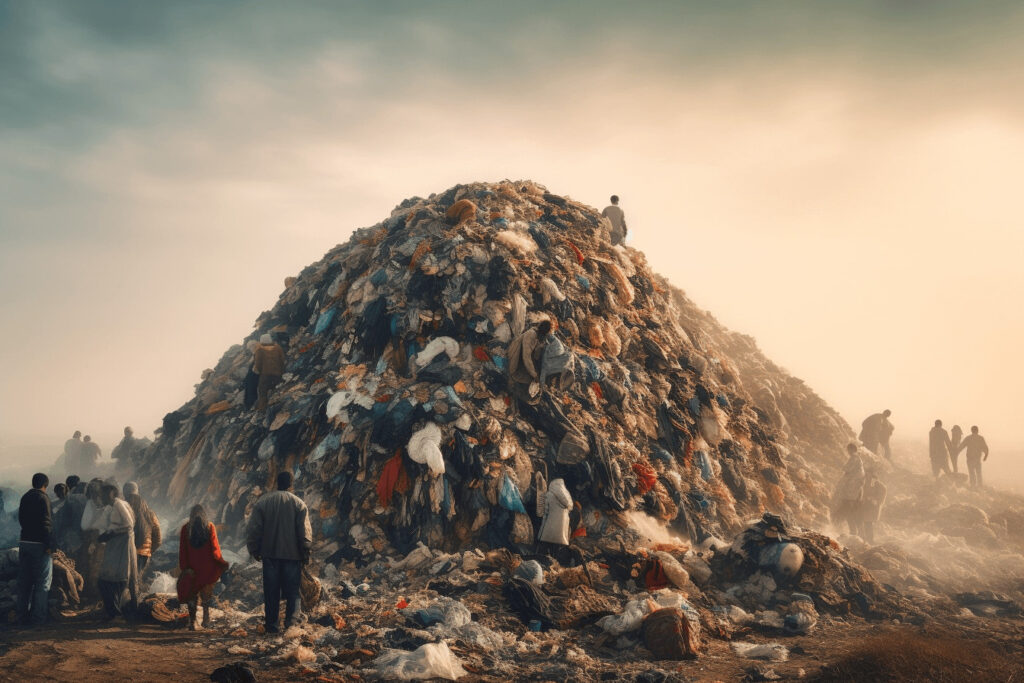
- High Volume of Textile Waste: The sheer amount of discarded clothing is constantly overwhelming landfill capacity. A recent survey has proven that the volume of garments Americans toss on a yearly basis has literally doubled in 20 years, going from 7 million tons to 14 million tons.
- Threat of Non-biodegradable Materials: Fast fashion brands usually use cheap synthetic fabrics in their product line. The decomposition of such textile materials in landfills contributes to the generation of methane, a potent greenhouse gas that significantly contributes to climate change. Methane emissions from landfills have a 28 times higher warming potential than carbon dioxide.
- Resource Exhaustion: According to the Ellen MacArthur Foundation, the equivalent of one garbage truck full of textiles is landfilled or incinerated every second worldwide. This excessive waste overloads landfill capacity and contributes to the depletion of natural resources, as new materials must be continuously produced to meet the demands of fast fashion.
- Complex Garment Construction: Fast fashion often involves complex stitching techniques, blended fibres, and trims, making it challenging to recycle and separate different components of garments.
- Inefficient Disposal Practices: Improper disposal of textiles, including incineration and illegal dumping, exacerbates the effects of fast fashion on the environment leading to air and soil pollution.
Carbon Emissions and Climate Change
The fashion industry accounts for roughly 10% of global carbon emissions. It’s a concerning fact that this sector’s production processes, starting from raw material extraction and textile manufacturing to dyeing, and finishing, contribute to extreme levels of emissions. And if that wasn’t enough, the energy-intensive operations adopted by garment factories suck in huge amounts of fossil fuels for electricity generation, increasing the carbon footprint.
Besides that, fast fashion relies on global supply chains, which involve transporting materials, components, and finished products over long distances. Shipping, air freight, and trucking further add to emitting carbon emissions, especially considering the large volumes and frequent turnover of goods. Some ways in which the environmental impacts of fast fashion is triggering climate change are:
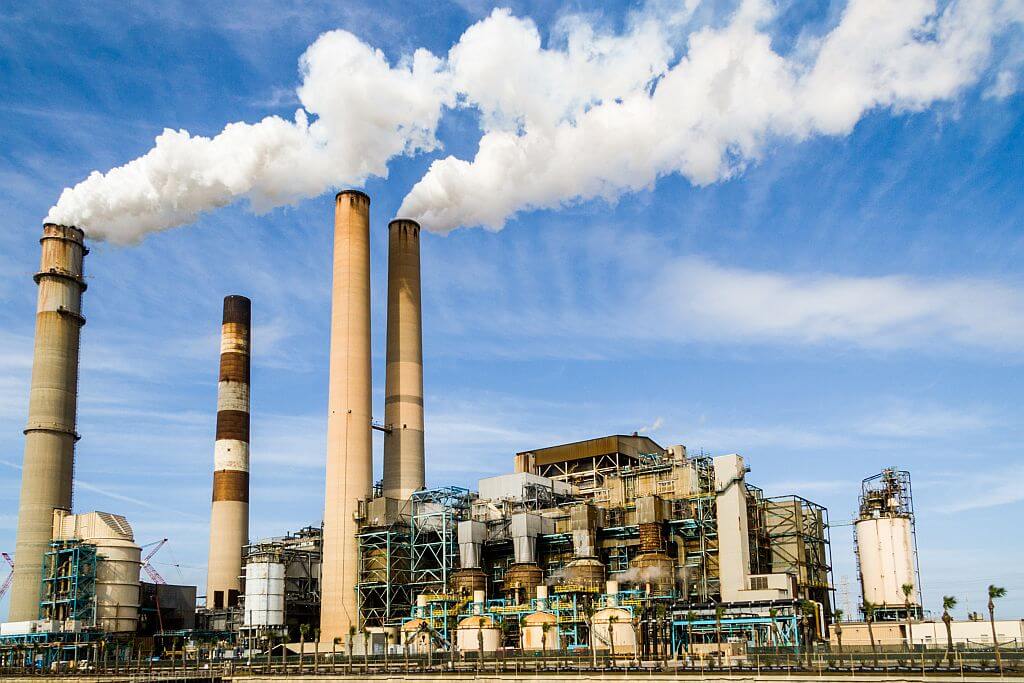
- Greenhouse Gas Effect: Carbon dioxide and other greenhouse gases released from the burning of fossil fuels trap heat in the atmosphere, leading to global warming. If things keep escalating at the current pace, then carbon emissions will soar by over 50% by 2030.
- Amplification of Climate Change: Carbon emissions from fast fashion, along with other industries, contribute to the cumulative effect of greenhouse gases, intensifying climate change impacts such as rising temperatures, extreme weather events, and sea-level rise.
- Feedback Loops: The climate crisis caused by carbon emissions can trigger feedback loops, such as the melting of ice caps and permafrost, which release additional greenhouse gases, further accelerating global warming.
Pollution and Chemical Usage
By using toxic chemicals and dyes, fast fashion manufacturing processes significantly kick in various environmental issues. Here are some key points regarding their impact:
- Chemical Usage: Fast fashion heavily relies on chemicals throughout the production process, including pesticides, fertilizers, synthetic dyes, and so on. These toxins pose severe risks to those who work or live near textile manufacturing facilities.
- Adulteration of Water: Untreated chemical-laden wastewater from apparel factories is often discharged directly into rivers and water bodies, leading to severe water pollution. According to the World Bank, 20% of global industrial water pollution comes from textile dyeing and treatment.
- Impact on Ecosystems: Synthetic dyes used in fast fashion contain numerous toxic substances, such as heavy metals, azo dyes, and formaldehyde. These substances harm aquatic life and can persist in the environment for long, disrupting ecosystems and posing risks to human health.
- Soil Contamination: Chemicals used in textile production can contaminate soil through various channels, like fertilizer usage, disposal of waste materials, or filthy water for irrigation. This pollution can affect soil fertility and the health of plants, impacting agricultural systems and food security.
Impact on Biodiversity and Natural Resources
From the depletion of natural resources to the destruction of habitats for raw material production— the environmental effects of fast fashion is sucking out life from our planet.
- Deforestation: The production of raw materials for fast fashion, such as wood-based fibers like rayon and viscose, contributes to deforestation. Forests are cleared to make way for agricultural land or logging activities, leading to loss of biodiversity, habitat loss, and increased carbon emissions.
- Soil Degradation: The continuous cultivation of crops like cotton without proper soil management practices can lead to soil degradation. Soil erosion, loss of fertility, and depletion of nutrients can occur, negatively impacting agricultural productivity and contributing to environmental degradation.
- Ecosystem Disruption: Unsustainable fashion practices can disturb ecosystems beyond raw material production. For example, extracting resources like oil for synthetic fibers or minerals for metal accessories involves catastrophic mining practices that can threaten local communities.

Greenwashing Practices by Fast Fashion Corporates
Greenwashing is a common practice among fast fashion companies where they use deceptive marketing strategies to present themselves as environmentally friendly and sustainable, despite of only engaging in unsustainable practices. Signs of greenwashing involve:
- Vague and Misleading Claims: Fast fashion companies often make general statements about being “green” or “eco-friendly” without providing specific details or valid information about their sustainability efforts. These claims can mislead consumers into believing that the company is more sustainable than it actually is.
- Token Sustainability Initiatives: Many fashion brands highlight sustainability programs such as eco-friendly product lines. However, these efforts usually represent a small fraction of their overall production.
- Lack of Transparency: Most fast fashion companies do not provide sufficient information about their supply chains, sourcing practices, or the environmental impact of their products. Without transparency, it becomes challenging for consumers to verify the authenticity of sustainability claims.
- Recycling and Circularity Initiatives: Companies may promote a circular economy by emphasizing their recycling programs. However, the actual rates of garment recycling are often low, and the overall business model of fast fashion contradicts the principles of a truly circular fashion industry.
The Social Perspective
Animal Cruelty
Industries have always benefitted by exploiting animals, and the fast fashion sector is no different. Brands often utilize animal-derived materials like fur, leather, silk, and wool to meet the rising demands of consumers. However, the use of these materials comes with its own set of consequences due to the cruel practices involved in animal agriculture:
- Mass Deforestation: Animal agriculture is land-intensive, particularly for cows and sheep, and requires large lands to make room for grazing and feed production. This results in clearing out forests resulting in biodiversity destruction.
- Carbon Footprint: Livestock production generates dangerous amounts of methane, charging climate change. The treatment and processing of animal-derived materials involve the use of toxic chemicals like chromium in leather tanning. Improper handling and disposal of these chemicals are one of the adverse environmental effects of fast fashion.
- High Water Consumption: Animal agriculture is water-intensive, requiring substantial amounts of water for animal hydration, feed production, and so on. The water footprint of animal-derived materials like leather and wool is high, contributing to water scarcity issues in regions with intensive livestock farming.
- Deficient Waste Management: Animals produce volumes of waste, including manure and carcasses. Inadequate waste management practices can give rise to severe environmental degradation caused by the rotting of such substances, even heightening the risks of diseases.
- Animal Welfare Concerns: Last but not least, animals are not for us to use! Utilizing animals’ skin and hair for fashion is gruesome and unethical in every way possible. Factory farming practices include overcrowding, inhumane living conditions, and ruthless slaughter, which are common in producing fur and leather.

Worker Exploitation and Sweatshops
Fast fashion = Inexpensive clothing! But while consumers enjoy trendy garments at cheap prices, it’s the workers who pay the higher cost. The relationship between worker exploitation, cost-cutting measures, low wages, and poor working conditions in the fast fashion industry is deeply intertwined. Brands that use sweatshops are in a relentless pursuit of low production costs. This system puts immense pressure on suppliers to meet demanding deadlines and price expectations, often at the expense of workers’ rights and well-being.
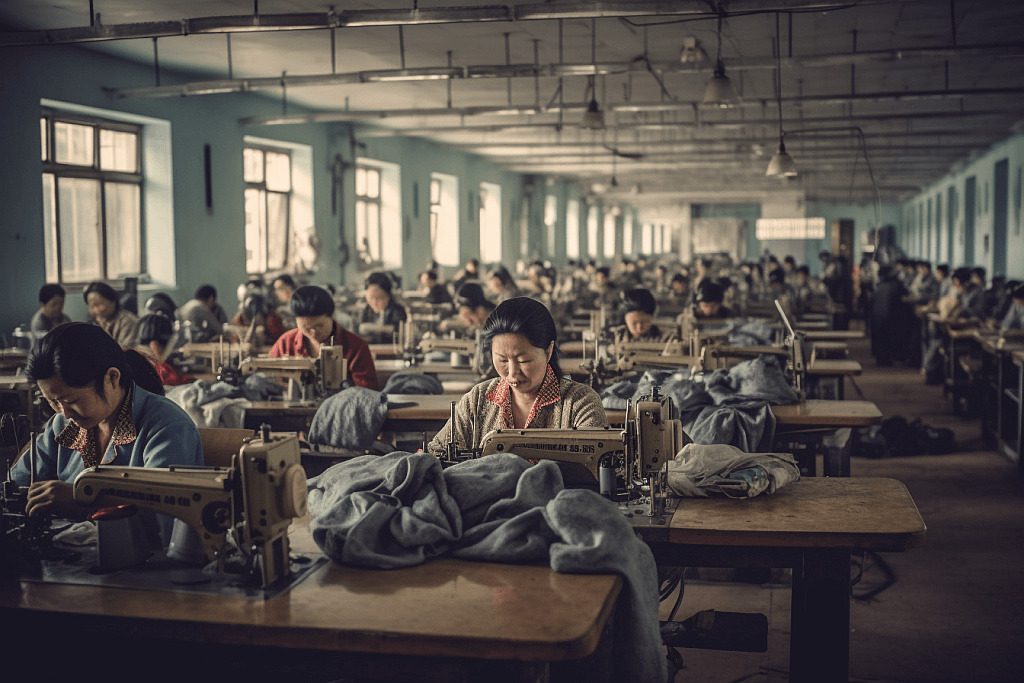
- Outsourcing and Subcontracting: Fast fashion brands often outsource their production to low-wage countries where labour laws and regulations are lax. They rely on subcontracting arrangements, which involve hiring multiple tiers of suppliers and contractors, creating a complex and opaque supply chain. This outsourcing model allows brands to distance themselves from direct responsibility for workers’ conditions and wages.
- Exploitative Working Conditions: Sweatshop factories typically subject workers to long working hours, often exceeding legal limits, without adequate breaks or overtime pay. Workers even face unsafe and unsanitary working environments, including crowded and poorly ventilated spaces.
- Abuse and Harassment: Reports of physical and verbal abuse, including gender and racial discrimination, are common in sweatshop factories. Workers, many of whom are vulnerable and marginalized, face harsh treatment from management, including threats, violence, and restrictions on their freedom of association.
- Low Wages: Fast fashion brands adopt cost-cutting measures to maintain low prices and maximize profit margins. This leads to meagre wages for garment makers in factories, often below living wage standards, perpetuating a cycle of poverty and exploitation.
- Child Labour: Child labour is banned all over the world. But developing countries freely force children to work for unreasonable hours, because of a negligent labour law system. At present, an estimated 250 million children between the age of 5-14 are employed in sweatshops worldwide, earning as less as 1 cent per hour.
- Lack of Labour Rights and Unions: Sweatshops strictly discourage workers from organizing unions or participating in collective bargaining. This approach prevents workers from advocating for better working conditions, fair wages, and improved labour rights.
Manipulation of Consumers

Awareness regarding fast fashion impact on environment is catching up the pace, but as consumers, you are being exploited too. Fast fashion labels employ various marketing tactics to foster a culture of overconsumption and impulsive buying.
- Fast-paced Trend Cycles: Fashion brands constantly introduce new styles, often replicating designs from high-end clothing houses. By rapidly churning out new collections, they create a sense of urgency and FOMO (fear of missing out) among consumers, encouraging them to constantly update their wardrobes to stay “in fashion.”
- Limited-time Deals: Fast fashion labels frequently use time-sensitive promotions, such as flash sales, limited editions, or discount codes, to create a sense of scarcity. These tactics push consumers to act quickly, leading to impulsive buying behaviors.
- Social Media Marketing: Nowadays, apparel companies, heavily rely on influencer marketing and social media platforms to promote their products. Influencers showcase the latest styles, creating a desire for constant novelty.
- Low Prices and “Perceived” Affordability: Fast fashion’s main appeal lies in its low prices. By offering economical clothing, brands make fashion more accessible to a wider audience. The affordability factor can entice consumers to buy more items, even if they don’t necessarily need them.
- Throwaway Mentality: Low prices create a throwaway attitude, where clothing is seen as disposable rather than durable. The cheap cost makes it easier to discard items after minimal use, contributing to the mounting waste and fueling the effects of fast fashion on the environment.
- Planned Obsolescence: Fast fashion brands produce garments with a short lifespan. The low-quality materials and poor stitching result in clothes that quickly lose their shape or become unwearable after a few washes. This planned obsolescence strategy prompts consumers to keep purchasing new items to replace deteriorated ones, perpetuating the cycle of overconsumption.
Together, We Can!
With concerted efforts, it is not really very difficult to minimize the negative environmental impact of fast fashion. There are various ways like embracing sustainable materials and ethical manufacturing practices, adopting conscious consumption habits and many more by which we can collectively minimize the detrimental effects of fast fashion on the environment. Together, we can work towards a more sustainable and responsible future of the fashion industry. Let’s have a look at some of these easily actionable steps.
Sustainable Material Alternatives
Planet-friendly green materials like organic cotton, linen, hemp, lyocell, and recycled polyester have gained significant popularity in fashion production due to their sustainability. These textiles offer numerous benefits, such as reduced chemical pollution, water conservation, preservation of biodiversity, and so much more, resulting in lower carbon emissions.
- Environmental Conservation: Sustainable fabrics have the least usage of harmful chemicals, pesticides, and synthetic fertilizers, minimizing soil and water pollution. Plus, recycled and organic materials and organic require fewer resources like water and energy during production.
- Waste Reduction: Recycled polyester and nylon are made from abandoned fishing nets, single-use plastic bottles, post-consumer plastic waste, and so on. This is an amazing approach to divert waste from landfills and utilize materials that already exist.
- Improved Worker and Community Health: Brands that use clean fabrics prioritize fair trade practices, laborers’ safety, and protection of the planet, ultimately ensuring the well-being of workers and local communities.
- Durability and Longevity: Most sustainable fabrics are celebrated for their durability. That’s why products made from them have a longer lifespan, reducing the need for frequent replacements.
- Enhanced Comfort: Sustainable fabrics feature incredible breathability, moisture-wicking, and hypoallergenic properties. They are super-comfy to put on and extremely gentle on your skin.
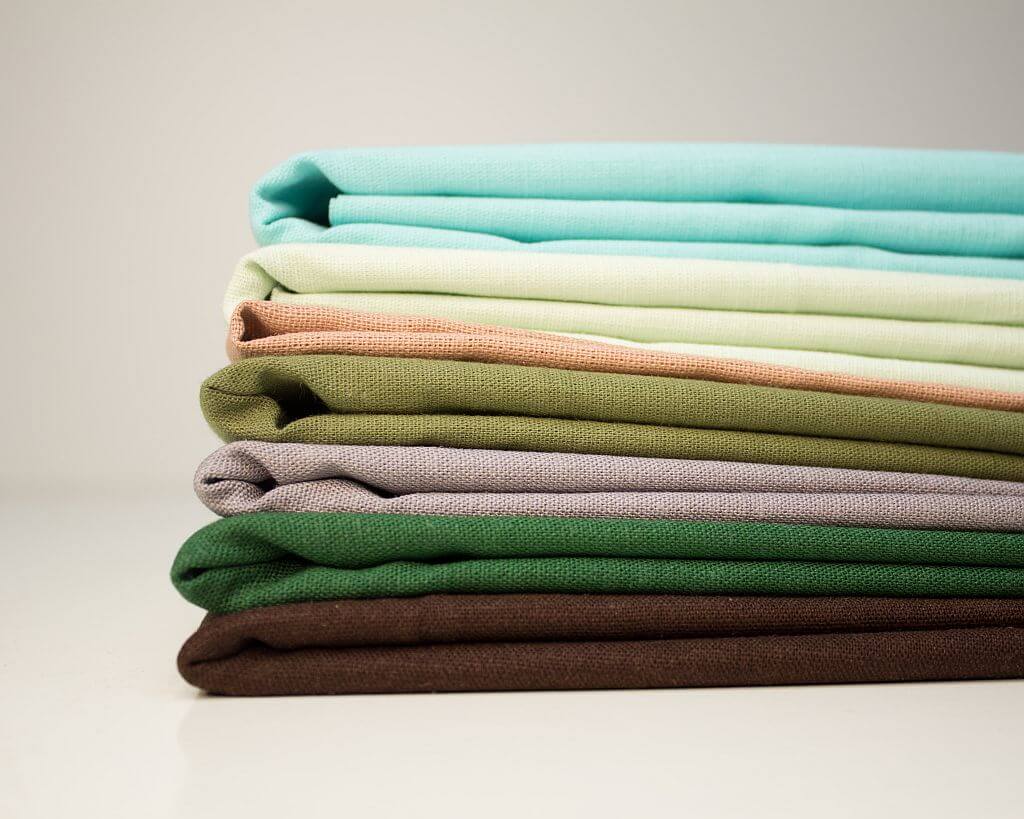
Circular Economy, Recycling, and Fashion Swapping
The promotion of adopting circular economy principles and recycling programs in the fashion industry is essential for addressing the environmental impacts of fast fashion. Advocating for the reuse of materials not only addresses the challenges posed by fashion’s linear production model but also fosters a more sustainable, resource-efficient, and environmentally conscious fashion industry.
- Reduction in Textile Waste: Recycling initiatives and material reuse help avert textile waste from landfills. Since the circular economy is all about repurposing existing items, it reduces the need for virgin resource extraction, conserving water, energy, and raw materials.
- Secondhand Markets: Promoting the sale and exchange of pre-owned clothing through thrift stores, consignment shops, online platforms, and clothing swaps encourages the reuse of garments instead of discarding them.
- Rental and Subscription Services: Offering clothing rental and subscription services allows consumers to access a variety of garments without the need for permanent ownership, reducing the demand for new clothing and extending the lifespan of existing items.
- Design for disassembly: Design garments and products that can be easily disassembled and separated for recycling at the end of their life cycle.
- Consumer Awareness: Circular fashion initiatives increase consumer engagement and educate them about the environmental effects of fast fashion. This approach encourages responsible consumption and empowers individuals to make more sustainable choices.
Slow Fashion and Ethical Consumption
Slow fashion is the exact opposite response of fast fashion and its disposable nature. It focuses on creating high-quality garments designed to last, emphasizing timeless styles and durability. This reduces the need for frequent wardrobe updates, decreasing the overall environmental impact of apparel production.
From reducing the strain on natural resources and curbing waste generation to incorporating kind-on-the-earth materials and supporting fair labour conditions— slow fashion is the ultimate opponent of fast fashion. As conscious consumers, slow fashion and ethical consumption is your sign to stand forth as an eco-warrior.
- Quality over Quantity: Instead of constantly chasing trends and accumulating tonnes of cheaply made garments, focus on investing in premium quality pieces that will last longer and have a lower environmental impact.
- Buy Less and Choose Well: You don’t need piles of fashionable clothing to look your best. Like, how many times has it happened that despite of having a closet full of garments, you are still confused about what to wear? And, you are not alone in this struggle! So, understand your lifestyle, your preferences and shop for styles that you will actually love to wear repeatedly.
- Prioritizing Timeless Styles: Opting for classic, versatile clothing allows you to build a more sustainable one-of-a-kind wardrobe that transcends short-lived fashion fads.
- Mindful Closet Planning: Plan your wardrobe. Or better yet, build a capsule wardrobe. Curate your outfits based on your needs and personal style with versatile pieces that can be easily mixed and matched.

Supporting Ethical and Sustainable Brands
Many apparel brands are trying to drive positive change in the fashion world by taking the lesser-walked path to sustainability, transparency, fair trade, and ethical practices throughout their supply chain. While no label is 100% perfect, it’s important to remember that sustainability is a journey. By supporting brands that are constantly making innovative and meaningful efforts, we can create a demand for responsible fashion.
But beware of greenwashing and make an informed choice by following the guidelines:
- Look for brands that are transparent about their supply chain. Check for certifications such as Fair Trade, Global Organic Textile Standard (GOTS), or Fair Wear Foundation, which ensure ethical practices.
- Choose brands that use sustainable materials like organic cotton, recycled fibers, linen, hemp, and lyocell. These materials do not harm the planet compared to conventional alternatives.
- Research if the brand has clear environmental policies and goals, such as reducing carbon emissions, water usage, and waste generation. Certifications like the B Corporation, Climate Positive, Carbon Neutral, Bluesign® or Oeko-Tex Standard 100 are an added advantage.
- Look for brands that prioritize quality craftsmanship and timeless designs. Customer reviews and ratings are a good way to gauge a label’s commitment to producing long-lasting products.
- Stick to labels that offer some form of a lifetime guarantee on their products. “Take back” or “Repair & Renew” programs are another sign of observing circularity.
- Consider supporting local and independent fashion brands that have smaller carbon footprints as they use locally sourced materials and local production, to support the domestic economy.
Repair and Upcycling
Repairing and upcycling clothing is a fantastic way to extend the life of your garments while unleashing your inner creativity. Here’s why you should consider these practices:
- Good for the Planet: Mending your clothing helps reduce textile waste. By fixing a small tear or replacing a zipper, you can keep using your garments for long instead of contributing to waste generation.
- Cost Savings: Upcycling your clothing is definitely more cost-effective than buying new items. Try to invest in quality pieces and maintain them over time to save money in the long run.
- Emotional Value: Many of our clothes hold sentimental value or have stories attached to them. By repairing them, you can preserve the memories associated with these pieces and continue to enjoy wearing them.
- Skill Development: Engaging in mending activities allows you to develop practical skills. From simple tasks like sewing on a button to more advanced techniques like patching or darning, you can acquire valuable skills that empower you to take better care of your clothing and lifestyle.
- Customization and Personalization: Through upcycling, you have the freedom to customize your clothing according to your preferences. You can add embellishments, alter the fit, or combine different fabrics to create one-of-a-kind pieces that truly represent your personal style.
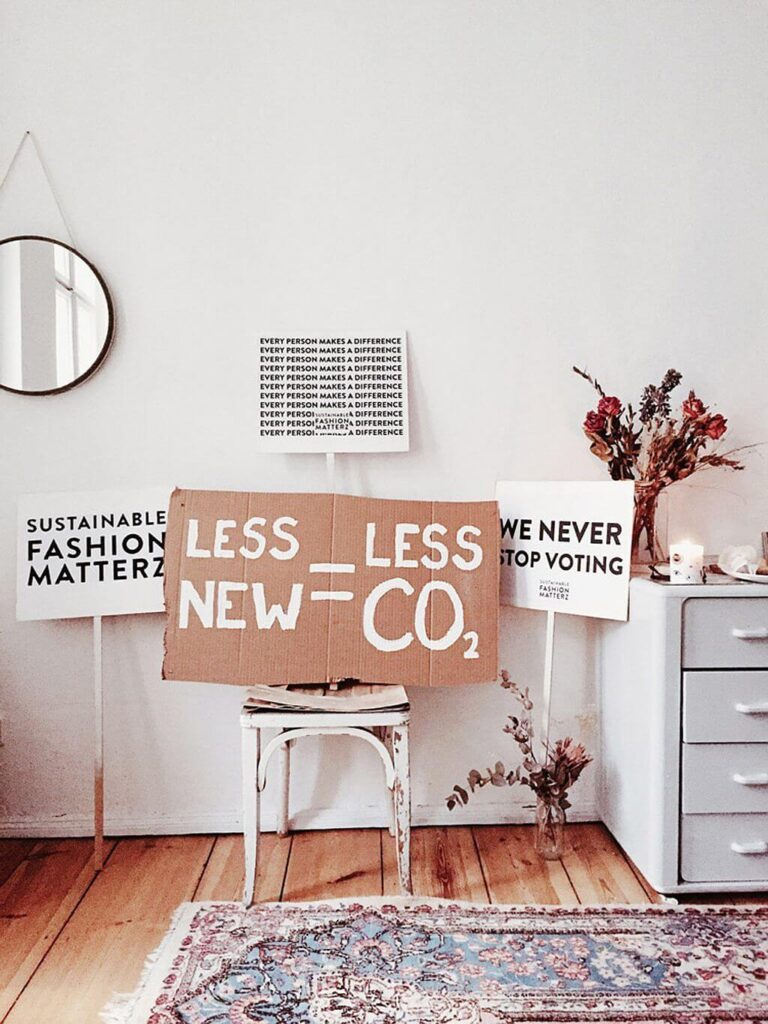
Consumer Education and Awareness
Mother Earth is in a crisis, and as consumers, you have a solid role to play in helping her heal. Educating yourself and others about the environmental impact of fast fashion is crucial to encourage conscious consumption habits and lead a sustainable lifestyle. Some ideas on how you can drive change for the “greater good” are:
- Stay updated: Read news regarding global warming, the factors causing it, and the latest technological advancements to reverse climate change. By staying up-to-date with the planet’s current condition with knowledge about both the positive and negative developments, you can stay motivated to do your bit.
- Embrace Minimalism: Less is more! Practice mindful shopping by only purchasing items you truly need and love. Focus on curating a clothing collection with minimalist pieces that can be effortlessly styled up or down as per the occasion.
- Share Information: Everyone is talking about the climate crisis, but many are unaware of the deets or what they can do to make things better. You can utilize social media platforms, blogs, or local community groups to share educational content and resources about sustainable fashion.
- Engage in Conversations: Discuss the topic with friends, family, and colleagues to create awareness about how their shopping decisions affect the environment. This way, you can influence others to make more mindful fashion choices.
- Support Sustainable Fashion Events: Attend or organize events that promote sustainable fashion, such as clothing swaps, upcycling workshops, or sustainable fashion shows.
- Long-term Impact: Widespread education can lead to a shift in consumer behaviour and ultimately pressure the fashion industry to adopt more sustainable practices.
Collaboration and Industry Responsibility
Comprehensive change can happen through purposeful collaborations between fashion brands, industry stakeholders, and policymakers. By fostering such combined endeavours, the entire system can collectively work towards reducing the effects of fast fashion on the environment, creating a more responsible and ethical industry.
- Complex Supply Chains: Fashion corporations operate through intricate supply chains involving multiple stakeholders. Partnerships enable coordinated efforts to address sustainability challenges throughout the value chain.
- Shared Resources and Expertise: By working together, brands, suppliers, NGOs, and policymakers can pool resources, knowledge, and expertise to develop innovative solutions and best practices.
- Influence and Market Power: Fashion brands significantly influence consumer behaviour and market trends. By adopting responsible practices, they can steer demand for eco-friendly products and boost positive change.
- Government Support: Policymakers play a vital role in creating an enabling environment for sustainable fashion. They can incentivize sustainable practices through regulations, tax incentives, research funding, and collaborations with industry stakeholders.
- Standards and Certifications: Governments can establish and enforce sustainability standards, certifications, and labelling schemes that provide consumers with clear information about the environmental impact of products.
- Industry Collaborations: Brands can join industry initiatives and collaborations focused on sustainability, such as the Fashion Revolution, Sustainable Apparel Coalition, or the Ellen MacArthur Foundation’s Make Fashion Circular initiative. These platforms facilitate knowledge sharing, collective action, and industry-wide change.
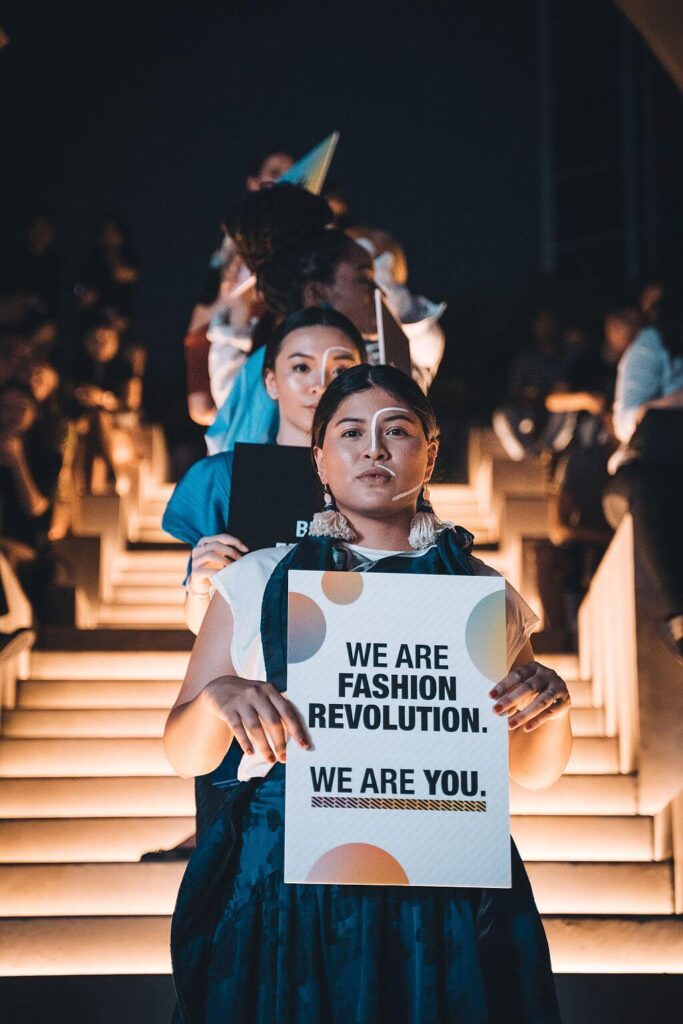
Policy and Regulation
World leaders have the utmost power. And it’s time they impose stronger regulations and policies to enforce sustainability standards in the fashion industry.
- Clear Guidelines: There’s an urgent need to enforce minimum sustainability standards, such as limits on pollution, water usage, and capping greenhouse gas emissions. These guidelines will provide a baseline for fast fashion brands to adhere to and help level the playing field.
- Ethical Labor Practices: Regulations can address labour rights, fair wages, and safe working conditions within the fashion industry. This ensures that brands prioritize human rights over towering profits.
- Supply Chain Disclosure: Governments can require fashion brands to disclose information about their supply chains, including sourcing practices, production facilities, and environmental impact. This transparency empowers consumers to make informed choices and facilitates accountability.
- Mandatory Reporting: Governments can mandate regular reporting on sustainability performance, forcing brands to measure and disclose their progress in achieving environmental targets. This reporting enables stakeholders to assess a brand’s commitment and progress towards sustainability.
- Research Funding: Governments can allocate resources for developing sustainable materials, technologies, and production processes. This support encourages innovation and accelerates the adoption of sustainable solutions.
- International Cooperation: Policymakers can collaborate on a global scale to establish common sustainability standards and regulations for the fashion industry. This collaboration ensures consistency, prevents greenwashing, and avoids a race to the bottom in terms of environmental and social standards.
- Alignment with International Agreements: Governments can align fashion industry regulations with international agreements such as the United Nations Sustainable Development Goals (SDGs) and the Paris Agreement. This integration promotes a holistic approach to sustainability and supports international efforts to combat climate change and protect the environment.
Concluding Thoughts…
The environmental impact of fast fashion is undeniable and calls for immediate action. While governments and corporations really need to take charge in enforcing better initiatives, as consumers, we too have a duty to drive change through conscious choices. By opting for sustainable fashion alternatives, supporting ethical brands, and embracing practices like recycling and upcycling, we can mitigate the harmful effects of fast fashion on the environment.
Moreover, encouraging industry reforms and promoting transparency can lead to a cleaner and greener fashion industry. So, let’s unite in our efforts to protect our “Home,” preserve its resources, and create a fashion landscape that values both style and sustainability. Because Together, We Can!







